It’s probably to our best benefit to maximize our cognition and consciousness while we’re prepping and studying for the MCAT and especially so when we go in, sit down, and actually take the test!
Though we may not even realize it, our brains are constantly activating our cognitive and consciousness associated processes. From taking a normal route to school/work to deciding which ingredient to get in a store to taking a stressful midterm exam, we’re all engaging and activating our brain’s cognitive and conscious ability!
Hopefully, after going through this chapter overview, you’ll be more comfortable with some of the main topics in learning and memory. Let’s get started!
Cognition and Consciousness on the MCAT: What You Need to Know
Topics on language and memory will be tested on the Psych/Soc section of the MCAT and can appear both as passage based and fundamental discrete questions.
Here at MCAT Mastery, we’ve calculated that you can expect about 3-4 questions concerning cognition and consciousness to appear on the MCAT!
Introductory psychology accounts for 65% of the content covered in the Psychological, Social, and Biological Foundations of Behavior, while introductory sociology covers about 30 of the content.
Important Sub-Topics: Cognition and Consciousness
A great way to review topics on cognition (as is the same with other topics) is to relate some of the topics to how you approach daily life — quick shoutout to the self-reference effect! You may see that some of the cognitive processes we cover might resonate with how you think on a daily basis.
Try to also pair the review for this chapter overview with our “Learning and Memory on the MCAT” and “Language Development on the MCAT” chapter overviews as some concepts may overlap, making it easier for you to learn!
1. Theories and Influencing Factors on Cognition
Let’s first start with a basic definition of cognition before getting into discussion about the theories, different types of cognition, etc. Cognition can most simply be defined as how the brain takes in and processes of new, incoming information.
The cognitive processing of information is just a fancy way of saying the wide variety of things we can do with that incoming information: we can analyze it, store it, use it for work, and so much more!
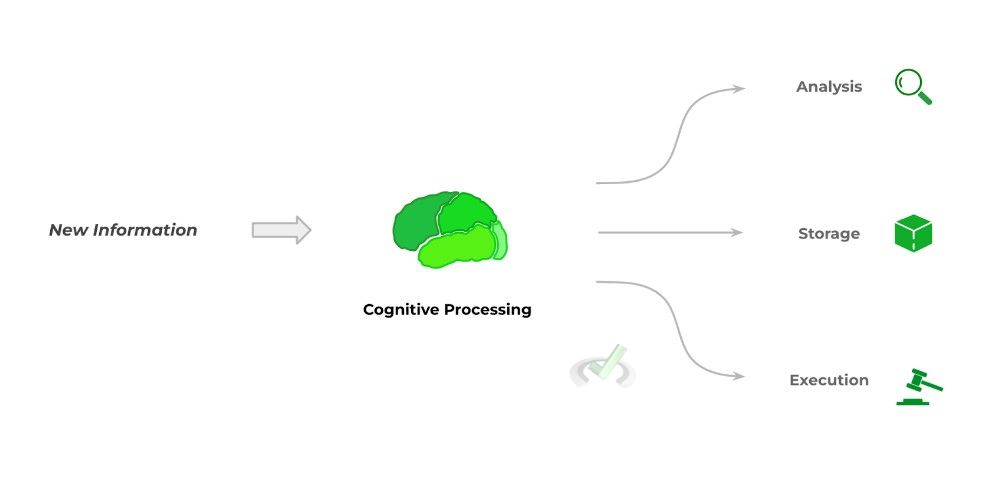
One theory of cognition, called the information processing model, takes inspiration from the way computers are designed and function. Proponents of this theory noted that the brain functions fairly similar to a computer: a computer receives an input, processes the input via the CPU, and sends a corresponding output.
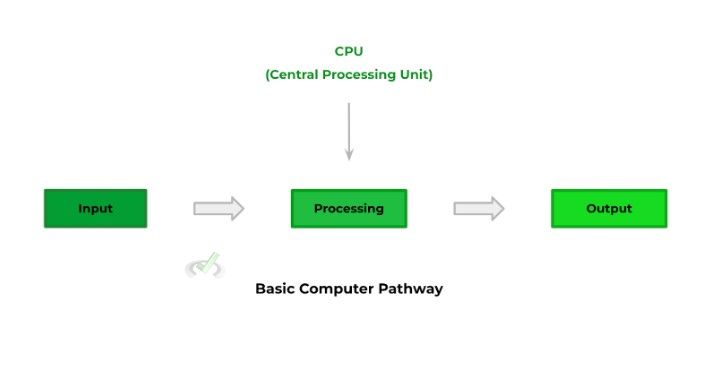
Similarly, the brain functions in a similar fashion: it can receive sensory information (input), process the sensory information, and engage in the appropriate response or behavior (output); however, there are still obvious differences.
The main difference is probably the way computers and brains process information: computers utilize a CPU with a strict set of algorithms while brains will utilize a wide variety of cognitive tools to aid in its processing — this includes short and long term memory, associated emotions, executive strategy and planning, and much more!
Finally, let’s delve into cognition on more of a biological level: when thinking and trying to form an association between cognition and the brain, the frontal lobe of the cerebral cortex should be your first bet!
If you’ve covered our “Neurobiology on the MCAT!” chapter overview, recall that the frontal lobe of the cerebral cortex is associated with higher executive function and cognition — these involve the brain’s ability to engage in abstract thinking, execute strategic planning, and much more!
Full Study Notes : Theories and Influencing Factors on Cognition
For more in-depth content review on various theories and factors that contribute to cognition, check out these detailed lesson notes created by top MCAT scorers.
2. Cognitive Approaches to Problem Solving
Whether it’s trying to simplify a certain mathematical equation or determining which football play to use given a certain defensive coverage, our cognition plays an active role in helping us solve problems and getting to a solution.
When approaching how to solve a problem, there are many different avenues and strategies we can take. We’ll go ahead and cover some of the main ones in this chapter overview — algorithms, trial and error, deductive reasoning, and inductive reasoning — and expand upon them in our in-detail article.
Let’s first contrast algorithms and trial and error: algorithms really on a set formula or method in order to solve a problem — a good phrase to associate with this is “do this, then do this”. Conversely, trial and error relies on blindly going into a problem and trying many different approaches until one finally works. Look at the example below!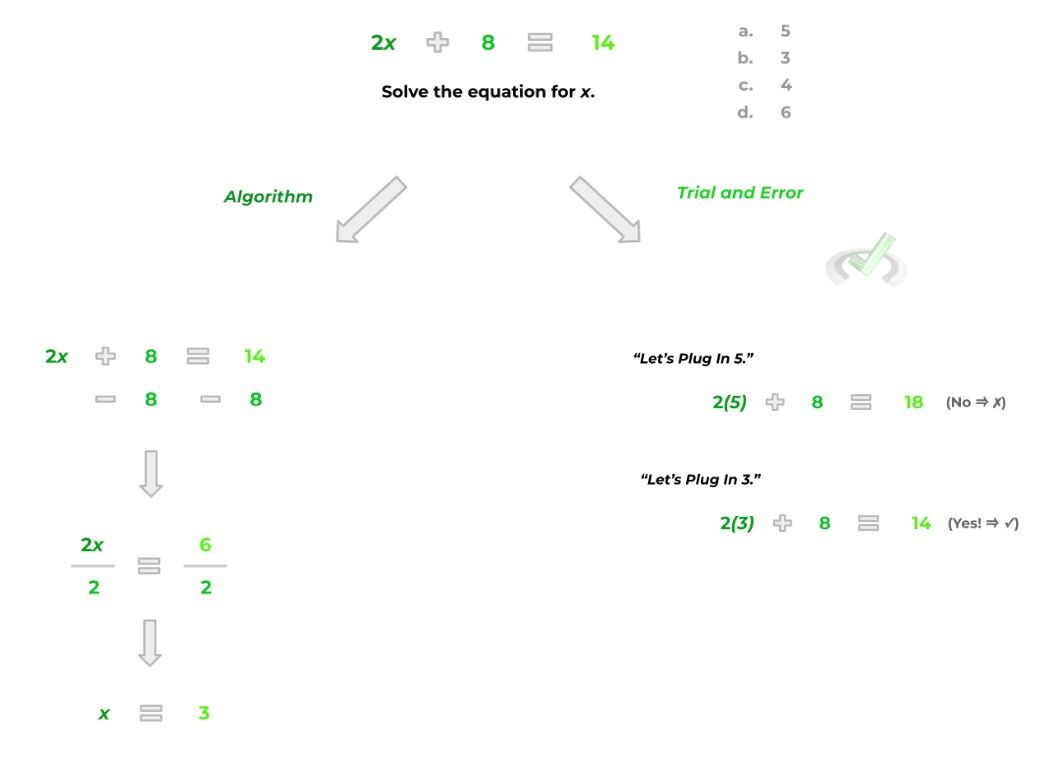
While algorithms are generally a more efficient and preferred approach to problem solving, there are certain cases where it would be appropriate to use trial and error such as situations where you have no prior knowledge or background when going into a problem!
Now, let’s contrast deductive and inductive reasoning — Sherlock Holmes is known for the latter! Both are trying to come to a conclusion about something; however, they differ in the starting information given to us to make our conclusion.
In deductive reasoning, we first start out with a general set of rules and guidelines in order to make a specific conclusion. Conversely, inductive reasoning starts with us noting very specific instances and observations and using them to draw a general conclusion.
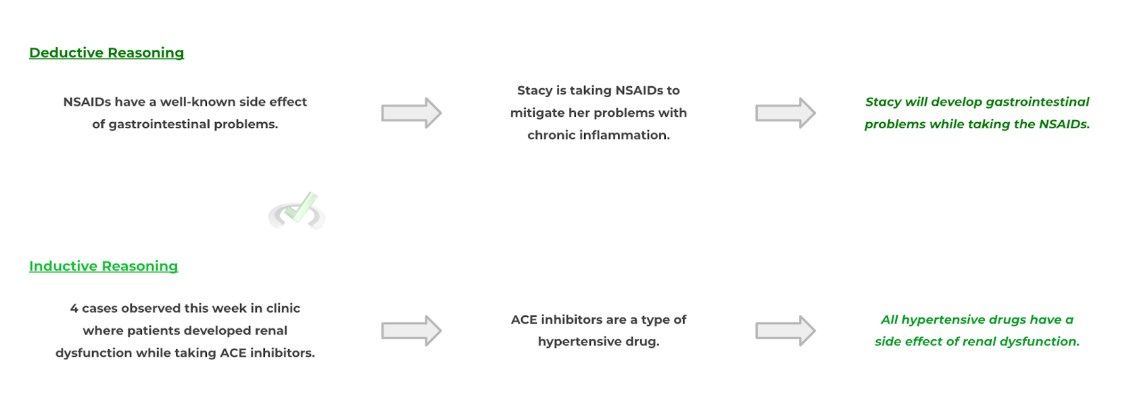
Notice also the contrast between “where we’re going” in regards to the 2 types of reasoning: in deductive reasoning, we’re going from general to specific while inductive reasoning involves us going from specific to general.
Give this article a read in order to get a fuller understanding of the different types of problem solving strategies we can employ!Full Study Notes : Cognitive Approaches to Problem Solving
For more in-depth content review on cognitive approaches to problem solving, check out these detailed lesson notes created by top MCAT scorers.
3. Types of Intelligences
Just as there are many different types of personalities and global cuisines, we’ve also identified a variety of intelligences that influence cognition! While it’s hard to narrow in on a specific definition of intelligence, try to generally think of it as our cognitive ability to retain and apply knowledge, engage in problem-solving, and much more!
While there have been many attempts and theories to explain intelligence, a great overall starting point is Howard Gardner’s theory of multiple intelligences. As the name implies, it supports the idea that there are many different types of intelligences — specifically 8 — each with its own specialization as shown below: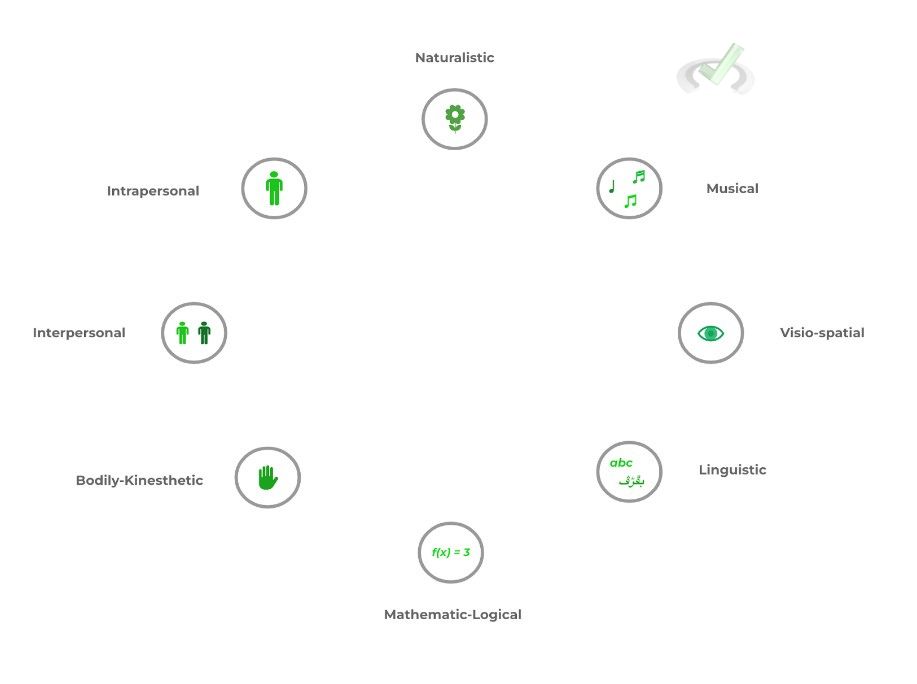
Though this theory has been criticized for its lack of other intelligences such as emotional intelligence as well as its strict categorization of intelligence into 8 groups, it’s still a great starting point!
Another way to group intelligences is to categorize them into fluid and crystallized intelligences. Fluid intelligence refers to one’s cognitive ability to think abstractly and approach problem solving from multiple angles. Crystallized intelligence refers to the accumulated facts, learning, and experiences that guide further problem solving.
To memorize the differences, think that fluid intelligence encourages “flexibility” such as abstract thinking. Conversely, try to think that facts are set in stone and “crystallized” like its respective intelligence!

Full Study Notes : Types of Intelligences
For more in-depth content review on intelligence and the various types of ways, check out these detailed lesson notes created by top MCAT scorers.
4. Types of Attention
Attention refers to our cognitive ability to hone and magnify specific sensory stimuli from the numerous sensory stimulations that are coming in our way: from the sounds, sights, smells, etc. There are 2 main types of attention that come with our cognition: selective and divided.
As the name implies, selective attention is the type of attention we use when we want to focus on one specific sensory stimulus such as when talking with a friend at a party with other things going on like music, other people talking, etc.
To use a sport example, consider a beginner basketball player trying to learn how to dribble: at first, they’re hyper focused on their kinesthetic sense and trying to master the movement of the hands and feet when dribbling the ball.
Conversely, divided attention is our cognitive ability to multitask in regards to focusing our attention on different subjects! Going back to the basketball analogy, a professional basketball player can allocate part of their attention to dribbling the basketball; however, because they can dribble so well, they can allocate another part of their attention to surveying the floor in order to make the right pass and play!
Full Study Notes : Types of Attention
For more in-depth content review on the different types of attention, check out these detailed lesson notes created by top MCAT scorers.
5. States of Consciousness in Wakefulness and Sleep Cycles
Though consciousness is a pretty difficult term to put a strict definition on, it’s best to think of consciousness as an individual's ability to perceive and be aware of reality — if you wanna get into a real debate about this definition, go ahead and watch The Matrix.
States of consciousness are best studied through using the electroencephalogram (EEG); if you’ve seen or reviewed the “Neurobiology on the MCAT!” chapter overview, recall that this brain imaging technique measures the electrical activity of the brain and displays them as brain waves.
We’ll sort brain waves into 2 main categories: 1) when we’re awake and 2) when we’re asleep. The 2 main waves that predominate when we’re awake are beta and alpha waves. Beta waves occur when we’re actively engaging in an activity while alpha waves are dominant when we’re awake but simply resting and relaxing.
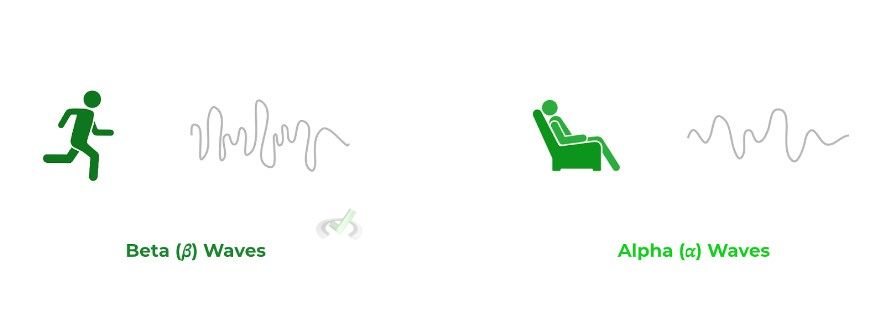
As we start to doze off, we get into our first stage of sleep which is characterized by theta waves which have a less frequency than the previously mentioned waves above. Getting into stages 3 and 4 is when we enter deep sleep and is characterized by the presence of delta waves (𝜹), which even have less frequency and high voltage!
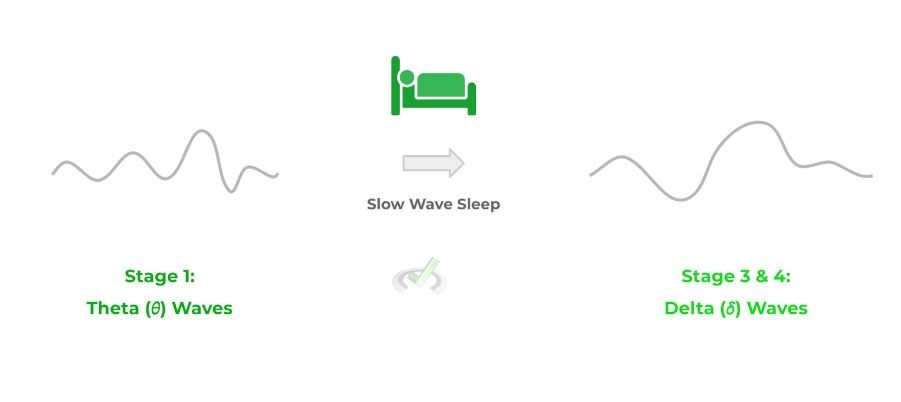
A great mnemonic device to utilize in order to remember the various waves in various stages of consciousness is BAT-D accompanied by the sentence, “BATs sleep during the Day”.
Full Study Notes : States of Consciousness in Wakefulness and Sleep Cycles
For more in-depth content review on various states of consciousness and wakefulness, check out these detailed lesson notes created by top MCAT scorers.
Important Definitions and Key Terms
Below are some high yield definitions and key terms to refer to when reviewing concepts and ideas about cognition and consciousness!
Term | Definition |
|---|---|
Information Processing Model | An adapted computer model to describe how cognition is accomplished by the brain, consisting of an input, processing, and output component |
Cerebral Cortex | Forebrain structure which is responsible for our higher level thinking and cognition, particularly the frontal lobe |
Algorithms | A type of problem solving strategy which involves the use of a set formula or strategy to obtain the correct answer |
Trial and Error | A type of problem solving strategy which involves blindly going into a problem and trying multiple different approaches until the correct answer pops up |
Deductive Reasoning | A type of problem solving strategy where specific conclusions are made from general statements |
Inductive Reasoning | A type of problem solving strategy where generalizations are made from specific observations |
Fluid Intelligence | A subdivision of intelligence that is characterized by being more abstract and has high emphasis of problem solving |
Crystallized Intelligence | A subdivision of intelligence that is characterized by the accumulation of facts and experiences and typically increases with age |
Selective Attention | A type of attention which refers to our cognitive ability to focus in on one sensory input from the entire sensory repertoire |
Mnemonic Devices | A type of attention which allows us to multitask and distribute our attention between difference sensory stimuli |
Beta (𝜷) Waves | A type of EEG measured wave which is predominant in states of alertness and active physical activity |
Alpha (𝜶) Waves |
A type of EEG measured waves which is predominant when we’re alert, but more or less, in a relaxed state |
Theta (𝟅) Waves |
A type of EEG measure wave which is predominant during stage 1 of sleep; will lead into slow wave sleep |
Delta (𝜹) Waves |
A type of EEG measured waves which is predominant in the stages of slow wave sleep, including stage 3 and 4 |
Additional Reading:
- Identity and Personality on the MCAT
- Language Development on the MCAT
- Learning and Memory on the MCAT
- Motivation and Emotion on the MCAT
- Neurobiology on the MCAT
- Psychological Disorders on the MCAT
- Sensation and Perception on the MCAT
- Social Interaction on the MCAT
- Social Processes and Behavior on the MCAT
- Social Structure and Stratification on the MCAT
- Social Thinking and Attitudes on the MCAT



 To help you achieve your goal MCAT score, we take turns hosting these
To help you achieve your goal MCAT score, we take turns hosting these 
























